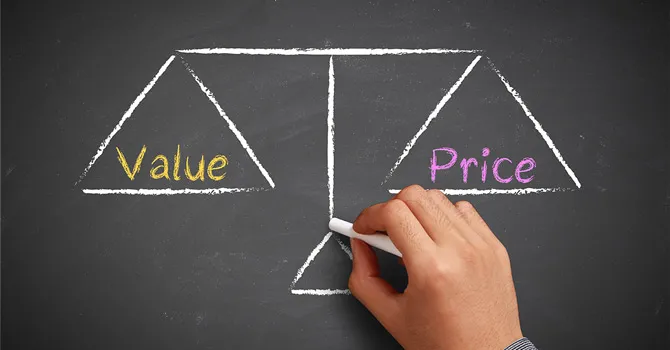Value-based pricing: A pricing approach that is often understood as the opposite of cost-based pricing. Is that true? And what’s more important: How does the method work and what are advantages as well as disadvantages of a value-based pricing model? Let’s find out:
Known as the pricing experts, value-based pricing is, of course, a pricing approach we often include in our consulting advice. However, we have found during our work that the term is not always so intuitively understood and is therefore sometimes misinterpreted. A shame: Since value-based pricing is a very worthwhile way for companies setting a price and to open up a whole new world to price products optimally.
Definition: What is value-based pricing?
Value-based pricing stands in contrast to other pricing approaches like the cost plus and the competitor-based pricing method. Production costs and competitors’ prices are of secondary consideration to calculate a product’s or service’s price – they are more like a safety net. When using a value-based pricing approach, companies aim to set prices that utilize consumers’ willingness to pay as effectively as possible. In short: Customers pay for the value their purchased goods offer them.
But how do companies find out which of their products’ and services’ attributes customers value? Which in turn determine what customers are willing to pay? They need to assign a price (as in, a quantified value) to every product feature or characteristic. The more total value a customer assigns to a product, the higher its price needs to be.
How to identify and quantify value drivers
Identifying and quantifying value-adding features is the greatest challenge for value-based pricing. There are three types of features that consumers associate with products and services:
- Hygiene factors: are a must for customers to even consider a purchase
- Preference drivers: determine whether a customer will buy this product or another
- Value drivers: motivate customers to pay a higher price
The last feature (value drivers) is one companies should especially focus on, since it can be used to justify higher prices. To determine which of your product’s features is a value driver, there are a number of market research methods available.
Once you have identified your value drivers, the next step is to find out what customers are willing to pay for your product. There are many direct and indirect questioning techniques you can use. For example a conjoint analysis, the Van Westendorp, or the Gabor-Granger method. From our experience, it is advisable to only use direct questioning techniques as a supplement to indirect ones. However, all of the mentioned methods to identify and quantify the value will help to determine the optimal value-based price.
Advantages & Disadvantages of value-based pricing tactics
Now you know the basics of a value-based pricing approach. But is it the right pricing strategy for your company? To determine this, we need to take a look at the pros and cons of value-based pricing.
What are the disadvantages of this pricing model? As you’ve read above, it requires quite an amount of research. On the one hand, to find out what your products’ and services’ value-drivers are. And on the other, to determine how they translate into customer’s willingness to pay (WTP) and higher price points.
However, in our opinion, the advantages of a value-based pricing model far outweigh the negatives. Value-based pricing fully taps into customers' willingness to pay and therefore enables manufacturers to unlock their monetization potential to the fullest. Also, the insights into which features make a product valuable also support companies in product development. They can be specifically tailored to the needs and desires of their customers.
Your strategy to professionalize your value-based pricing method
To anchor value-based pricing into your pricing calculation strategy and sales approach, there are a couple of measures. In order to safeguard your revenues, you can work on the following action items to professionalize your company’s pricing strategy. This might be especially pressing during a time when rising inflation is dwindling profit margins:
- Know your customer: By developing personas or buyer profiles, you’ll be able to better understand your customers’ buying criteria as well as your positioning from the customer’s perspective along the customer journey. All of this will affect the price they are willing to pay.
- Do your research: You need to quantify the monetary value and benefits your goods or services offer to customers. This freshly gained transparency regarding consumers’ value perception then enables you not only to fully skim their willingness-to-pay, but also gain a competitive edge by identifying new business segments.
- Empower your sales team: Ensure consistent value communication with guidelines and “battle cards” that translate technical dialogues and product features into customer value.
- Shift your mind-set: You have to conduct targeted sales trainings to anchor a value culture in your sales department and increase value-based pricing capabilities.
Summary: Set up your value-based pricing model now!
As you can see, a holistic value-based pricing approach needs proper analysis, quantification, and communication to achieve higher profit margins. Start the process to identify your products’ and services’ value drivers as well as your customers’ preferences and how they assign value now. With this you will be well equipped to monetize your offer most effectively and secure optimal margins.

